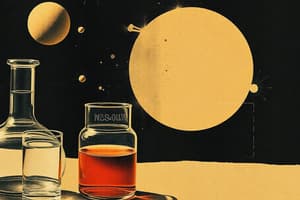Podcast
Questions and Answers
What are suspensions?
What are suspensions?
- Mixtures that cannot be filtered
- Mixtures with large particles (correct)
- Mixtures with medium-sized particles
- Mixtures with very small particles
What are colloids?
What are colloids?
- Mixtures with small particles
- Mixtures with large particles
- Mixtures with medium-sized particles (correct)
- Mixtures that are easily filtered
What are solutions?
What are solutions?
- Mixtures that can be easily separated
- Mixtures with very small particles (correct)
- Mixtures that scatter light
- Mixtures that cannot be filtered (correct)
Particles in a suspension can remain mixed indefinitely.
Particles in a suspension can remain mixed indefinitely.
Provide an example of a suspension.
Provide an example of a suspension.
What characteristics do colloids have?
What characteristics do colloids have?
In a suspension, particles are so large that they _____ or block light.
In a suspension, particles are so large that they _____ or block light.
Match the following terms with their definitions:
Match the following terms with their definitions:
Which statement about colloids is true?
Which statement about colloids is true?
Which of the following is an example of a solution?
Which of the following is an example of a solution?
Flashcards are hidden until you start studying
Study Notes
Suspensions
- Composed of large particles that do not remain mixed and create a heterogeneous mixture.
- Examples include Italian dressing, dusty air, asthma inhalers, and snow globes.
- Display Tyndall effect: particles scatter or block light due to their size.
- Can be separated through filtration or settling.
- Notable for temporary mixtures where particles may settle over time.
Colloids
- Consist of medium-sized particles that are larger than those in solutions but smaller than those in suspensions.
- Homogeneous in nature; individual particles are not visible.
- Examples include processed milk, Jell-O, foggy air, jelly, and whipped cream.
- Particles remain mixed and cannot be filtered; exhibit Tyndall effect.
- Stay mixed and do not settle over time.
Solutions
- Made up of very small particles that create a homogeneous mixture; cannot see individual components.
- Soluble and stay mixed like colloids, but do not scatter light.
- Examples include cola, lemonade, alloys, anti-freeze, air, and salt water.
- Cannot be filtered, as particles are too small to separate.
Studying That Suits You
Use AI to generate personalized quizzes and flashcards to suit your learning preferences.




